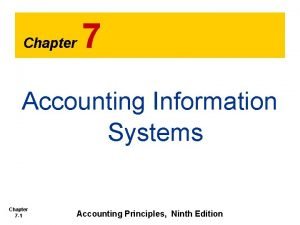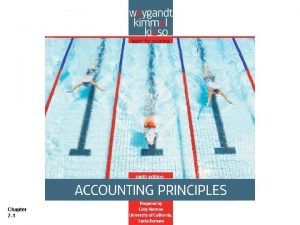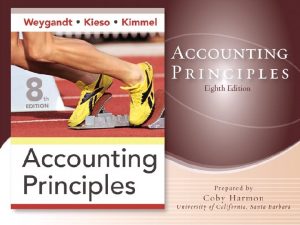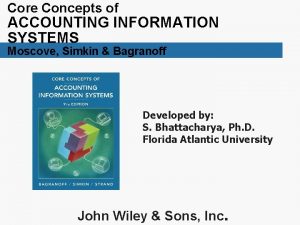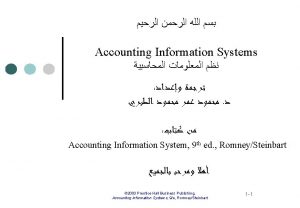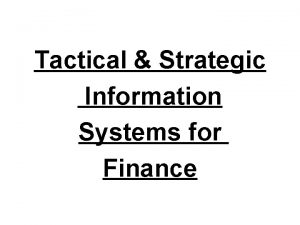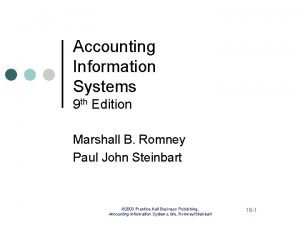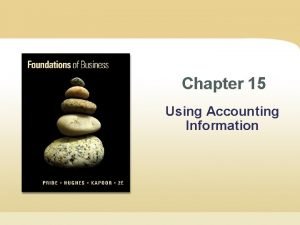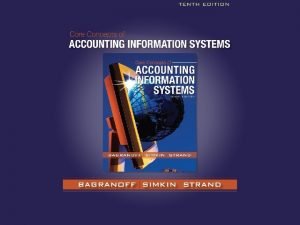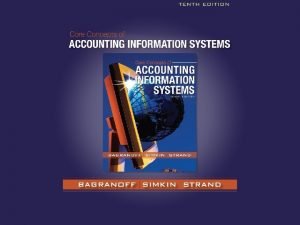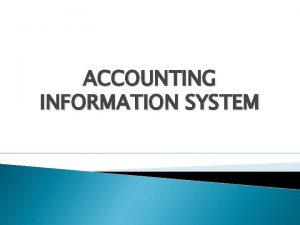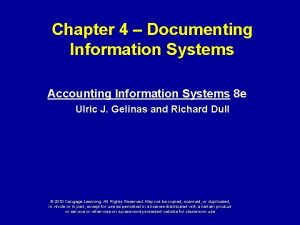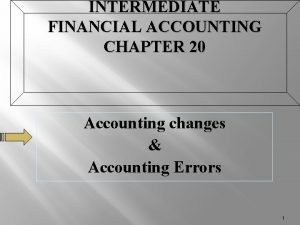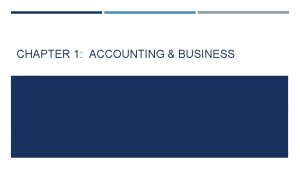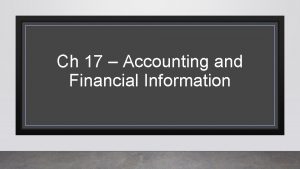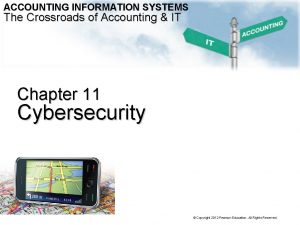Chapter 7 Accounting Information Systems Chapter 7 1
















- Slides: 16

Chapter 7 Accounting Information Systems Chapter 7 -1 Accounting Principles, Ninth Edition

Subsidiary Ledgers. A Subsidiary ledger is a group of accounts with a common characteristic, assembled together to facilitate the recording process by freeing the general ledger from details concerning individual balances. Used to keep track of individual balances. Two common subsidiary ledgers are: 1. Accounts receivable (customers’) 2. Accounts payable (creditors’) Each general ledger control account balance must equal the composite balance of the individual accounts in the related subsidiary ledger. Chapter 7 -2 SO 2 Describe the nature and purpose of a subsidiary ledger.

Subsidiary Ledgers Relationship of general ledger and subsidiary ledgers Illustration 7 -3 Chapter 7 -3 SO 2 Describe the nature and purpose of a subsidiary ledger.

Subsidiary Ledgers Advantages of Subsidiary Ledgers 1. Show in a single account transactions affecting one customer or one creditor. 2. Free the general ledger of excessive details. 3. Help locate errors in individual accounts. 4. Make possible a division of labor. Chapter 7 -4 SO 2 Describe the nature and purpose of a subsidiary ledger.

Special Journals Review Question Each of the following is a subsidiary ledger except the: a. accounts receivable ledger. b. accounts payable ledger. c. customer’s ledger. d. general ledger. Chapter 7 -5

Special Journals- IN OUTLINE QUIZ ON THIS Used to record similar types of transactions. Illustration 7 -5 If a transaction cannot be recorded in a special journal, the company records it in the general journal. Chapter 7 -6 SO 3 Explain how companies use special journals in journalizing.

Special Journals Sales Journal Illustration 7 -6 Under a perpetual inventory system, one entry at selling price in Sales Journal results in a debit to Accounts Receivable and a credit to Sales. Another entry at cost results in a debit to Cost of Goods Sold and a credit to Merchandise Inventory. Chapter 7 -7 SO 3 Explain how companies use special journals in journalizing.

Special Journals Illustration 7 -7 POSTING THE SALES JOURNAL Companies make daily postings from the sales journal to the individual accounts receivable in the subsidiary ledger. Chapter 7 -8 SO 3 Explain how companies use special journals in journalizing.

Special Journals Illustration 7 -7 POSTING THE SALES JOURNAL Posting to the general ledger is done monthly. Chapter 7 -9 SO 3 Explain how companies use special journals in journalizing.

Special Journals Cash Receipts Journal Illustration 7 -9 In the cash receipts journal, companies record all receipts of cash. The posting of the cash receipts journal is similar to the posting of the sale journal. “Other Accounts can include Capital, Drawing, & Prepaids. Chapter 7 -10 An (x) below the "Other Accounts" column in a cash receipts journal indicates the total is not posted to the general ledger.

Special Journals Review Question Cash sales of merchandise are recorded in the: a. cash payments journal. b. cash receipts journal. c. general journal. d. sales journal. Chapter 7 -11 SO 3 Explain how companies use special journals in journalizing.

Special Journals Illustration 7 -13 Purchases Journal Daily postings are made from the purchases journal to the accounts payable subsidiary ledger. Chapter 7 -12 SO 4 Indicate how companies post a multi-column journal.

Special Journals Illustration 7 -13 Purchases Journal At the end of the accounting period, the company posts totals to the general ledger. Chapter 7 -13 SO 4 Indicate how companies post a multi-column journal.

Special Journals Cash Payments Journal Illustration 7 -16 In a cash payments (cash disbursements) journal, companies record all disbursements of cash. The procedures for posting the cash payments journal are similar to those for other journals. In posting a multi-column journal, the total of the Other Accounts column is not posted. Chapter 7 -14 SO 4 Indicate how companies post a multi-column journal.

Special Journals Review Question Cash payments of merchandise are recorded in the: a. cash payments journal. b. cash receipts journal. c. general journal. d. purchases journal. Chapter 7 -15 SO 4 Indicate how companies post a multi-column journal.

In what journal would the following transactions be recorded? 1. 2. 3. 4. 5. 6. 7. 8. 9. 10. 11. 12. 13. 14. 15. 16. Cash received from signing a note payable. Investment of cash by the owner of the business. Closing of the expense accounts at the end of the year. Purchase of merchandise on account. Credit received for merchandise purchased and returned to supplier. Payment of cash on account due TO a supplier. Made a refund to a customer as an allowance for damaged goods. Received collection from customer within the 3% discount period. Purchased merchandise using cash. Paid a creditor within the 3% discount period. Made a refund to a customer as an allowance for damaged goods. Received collection from customer within the 3% discount period. Purchased merchandise for cash. Paid a creditor within the 3% discount period. Received collection from customer after the 3% discount period had expired. Paid freight on merchandise purchased. Chapter 7 -16
 Chapter 7 accounting information systems
Chapter 7 accounting information systems Chapter 7 accounting information systems
Chapter 7 accounting information systems Chapter 7 accounting information systems
Chapter 7 accounting information systems Accounting information system chapter 1
Accounting information system chapter 1 Core concepts of accounting information systems
Core concepts of accounting information systems Accounting information system شرح
Accounting information system شرح What is tactical information system
What is tactical information system Accounting information systems marshall b romney
Accounting information systems marshall b romney Financial accounting chapter 1
Financial accounting chapter 1 Cash control systems
Cash control systems Chapter 15 using management and accounting information
Chapter 15 using management and accounting information Chapter 3 the accounting information system
Chapter 3 the accounting information system Accounting information system chapter 1
Accounting information system chapter 1 Accounting information system chapter 1
Accounting information system chapter 1 Accounting information system chapter 1
Accounting information system chapter 1 Management information system chapter 1
Management information system chapter 1 Chapter 8 securing information systems
Chapter 8 securing information systems
